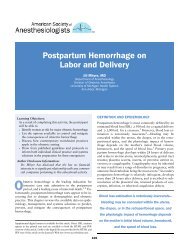A Fire in the Operating Room: It Could Happen to You! - Vtr
A Fire in the Operating Room: It Could Happen to You! - Vtr
A Fire in the Operating Room: It Could Happen to You! - Vtr
You also want an ePaper? Increase the reach of your titles
YUMPU automatically turns print PDFs into web optimized ePapers that Google loves.
A<strong>Fire</strong><strong>in</strong><strong>the</strong>Operat<strong>in</strong>g<strong>Room</strong><br />
FIGURE 1. The fire triangle. rECRI Institute. Used with permission.<br />
of N2O, and elim<strong>in</strong>at<strong>in</strong>g residual volatile liquids. The<br />
problem <strong>in</strong> <strong>the</strong> OR is that no s<strong>in</strong>gle person is look<strong>in</strong>g at all<br />
three parts of <strong>the</strong> fire triangle. Usually <strong>the</strong> heat or ignition<br />
source is <strong>in</strong> <strong>the</strong> hands of <strong>the</strong> surgeon, <strong>the</strong> fuel is overseen by<br />
<strong>the</strong> nurs<strong>in</strong>g staff, and <strong>the</strong> oxidizer is controlled by <strong>the</strong> anes<strong>the</strong>sia<br />
team. The danger of fires is mostly smoke and <strong>to</strong>xic<br />
products of combustion, which can <strong>in</strong>clude carbon monoxide,<br />
ammonia, and cyanide. Although ORs <strong>to</strong>day conta<strong>in</strong><br />
spr<strong>in</strong>kler systems, it is rare that a fire gets hot enough <strong>to</strong><br />
activate <strong>the</strong> spr<strong>in</strong>kler. Once a fire is started, if it is not quickly<br />
ext<strong>in</strong>guished, <strong>the</strong> smoke from burn<strong>in</strong>g materials can quickly<br />
fill <strong>the</strong> OR and present a risk of asphyxia <strong>to</strong> OR personnel.<br />
Clearly, <strong>the</strong> best strategy <strong>to</strong> prevent a fire is by<br />
isolat<strong>in</strong>g <strong>the</strong> components of <strong>the</strong> fire triad. This<br />
<strong>in</strong>cludes m<strong>in</strong>imiz<strong>in</strong>g risk by decreas<strong>in</strong>g <strong>the</strong><br />
oxygen concentration, avoid<strong>in</strong>g use of N2O,<br />
and elim<strong>in</strong>at<strong>in</strong>g residual volatile liquids.<br />
PREPARATION AND PREVENTION<br />
Prepar<strong>in</strong>g for an OR fire is probably one of <strong>the</strong> best ways <strong>to</strong><br />
help prevent it. <strong>It</strong> is always important <strong>to</strong> determ<strong>in</strong>e<br />
whe<strong>the</strong>r or not a high-risk situation exists. If it does, <strong>the</strong><br />
team should discuss <strong>the</strong> strategy <strong>to</strong> prevent a fire and how<br />
<strong>to</strong> manage one should it occur. Ideally, this can be covered<br />
dur<strong>in</strong>g <strong>the</strong> surgical timeout, when it is extremely important<br />
FIGURE 2. A fire on <strong>the</strong> patient can <strong>in</strong>volve <strong>the</strong> drapes, surgical <strong>to</strong>wels, and<br />
<strong>the</strong> gel pad. rECRI Institute. Used with permission.<br />
<strong>to</strong> have a patient safety discussion <strong>in</strong> which <strong>the</strong> specific fire<br />
risk can be addressed.<br />
OR fires can be classified <strong>in</strong><strong>to</strong> two types: those that occur<br />
<strong>in</strong> <strong>the</strong> patient and those that occur on <strong>the</strong> patient. <strong>Fire</strong>s<br />
<strong>in</strong> <strong>the</strong> patient <strong>in</strong>clude those <strong>in</strong> <strong>the</strong> tracheobronchial tree, <strong>in</strong><br />
<strong>the</strong> chest dur<strong>in</strong>g open heart and thoracic surgeries, and<br />
<strong>in</strong>traabdom<strong>in</strong>al fires. <strong>Fire</strong>s on <strong>the</strong> patient will <strong>in</strong>clude those<br />
with burn<strong>in</strong>g drapes, gel pads, <strong>the</strong> patient’s hair, and prep<br />
solutions (Figure 2). In modern times, <strong>the</strong> most serious<br />
<strong>in</strong>traoperative fires have occurred with laser or electrocautery<br />
<strong>in</strong> an oxygen-enriched environment <strong>in</strong> <strong>the</strong> airway.<br />
6–14 If an endotracheal tube with a high concentration<br />
of O2 or O2/N2O is set on fire, it produces a ‘‘blow<strong>to</strong>rch’’<br />
effect and a large amount of debris will be deposited <strong>in</strong><strong>to</strong><br />
<strong>the</strong> lungs (Figure 3A, B).<br />
In modern times, <strong>the</strong> most serious<br />
<strong>in</strong>traoperative fires have occurred with laser<br />
or electrocautery <strong>in</strong> an oxygen-enriched<br />
environment <strong>in</strong> <strong>the</strong> airway.<br />
Lasers<br />
Laser is an acronym for light amplification by stimulated<br />
emission of radiation. Laser light is produced when energy<br />
is aimed at <strong>the</strong> ‘‘las<strong>in</strong>g medium.’’ The medium <strong>the</strong>n becomes<br />
<strong>the</strong> name of <strong>the</strong> laser. For <strong>in</strong>stance, electrical energy<br />
aimed at carbon dioxide (CO2) molecules is a CO2 laser.<br />
Laser light is coherent, which means it can be focused <strong>in</strong><strong>to</strong><br />
very small spots with very high powered densities. Common<br />
devices used <strong>in</strong> <strong>the</strong> OR are <strong>the</strong> Nd:YAG and <strong>the</strong> CO 2<br />
lasers. A helium-neon low-power laser is also frequently<br />
used <strong>to</strong> aim <strong>the</strong>se o<strong>the</strong>r lasers.<br />
When perform<strong>in</strong>g upper airway surgery, it is common <strong>to</strong><br />
use an endotracheal tube <strong>to</strong> ventilate <strong>the</strong> patient. In <strong>the</strong>se<br />
<strong>in</strong>stances, <strong>the</strong> tracheal tube must be specifically resistant <strong>to</strong><br />
<strong>the</strong> laser that is be<strong>in</strong>g used. <strong>It</strong> should consist of two cuffs<br />
27




